Coronavirus stories from the frontline: One week in America’s battle

More than 2.4 million people across the globe have tested positive for the new coronavirus, a pandemic that has shuttered cities, overwhelmed hospitals, terrified communities and sent the economy into what is likely to be a new depression.
The battle against the virus has evolved rapidly in just four months, from a small cluster of unexplained pneumonia cases in Wuhan, China, to a secretive Christian sect in South Korea to the centers of European fashion and commerce.
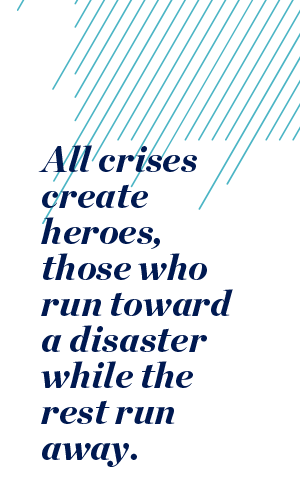 But nowhere has the virus hit harder than in the United States, where policymakers were slow to respond to early warnings of its potential spread. More than 787,000 people in the U.S. have been infected, a total that is higher than the number of confirmed cases in Spain, Italy, France and Germany combined.
But nowhere has the virus hit harder than in the United States, where policymakers were slow to respond to early warnings of its potential spread. More than 787,000 people in the U.S. have been infected, a total that is higher than the number of confirmed cases in Spain, Italy, France and Germany combined.
More than 42,000 lives have been lost in the U.S. Many thousands more will die in the coming weeks and months.
All crises create heroes, those who run toward a disaster while the rest run away. On Sept. 11, 2001, it was the New York City firemen who gave their lives trying to save others. After Hurricane Katrina, it was the Cajun Navy that picked up residents stranded on their rooftops by rising water. In any war, it is the people who volunteer to put themselves in harm’s way.
As the coronavirus outbreak’s death toll rises, it is increasingly the health care worker who has become the object of American pride. For all that is wrong with the nation’s health care system, the doctors who serve in emergency rooms, the nurses who take a patient’s vital signs, the EMTs who drive the ambulance are becoming the symbols of all that is right with the nation itself.
The Hill spoke to 10 health care providers who have come face to face with the coronavirus in recent weeks, from a hospital administrator who is preparing for a pandemic of despair to a nurse who is treating her own colleague; from doctors whose understanding of the virus is improving the way they are treating patients to a nursing home director whose fast action saved lives; from doctors in the heart of big-city outbreaks to doctors in rural emergency rooms who are still waiting for the surge.
These are their stories.
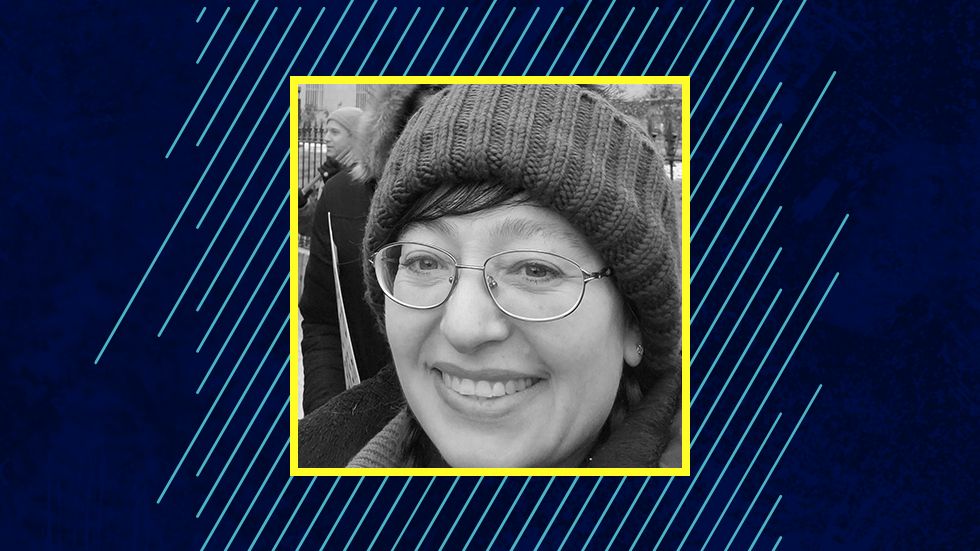
The nurse treating her own colleague
At first, the nurses at the Kaiser Permanente Medical Center in Fresno, Calif., didn’t pay much attention to the coronavirus circulating through China. It seemed a far-off threat, and even if it did come to the United States, the odds that it would show up in California’s out-of-the-way Inland Empire seemed unlikely.
“We weren’t really sure exactly what the truth of the matter was. Was this a hoax? Was this something that was restricted to other countries?” said Amy Arlund, a critical care nurse who has worked the night shift at the hospital for 19 years.
But on March 8, Arlund got a call from her boss, asking her to volunteer to treat the first confirmed coronavirus patient.
“I volunteered. I thought, OK, one or two cases is no big deal. Within a matter of two weeks, we had dozens,” she said. “It was one patient, then two, and then all of a sudden six. Then 11.”
Arlund’s life has been turned on its head. Nurses are told to keep their personal protective gear on as they move from room to room, preserving supplies but also potentially exposing those who are not infected. Even the supplies they are told to use to clean their masks are running low.
“These last couple of weeks are getting rough. Supplies are dwindling. We are being asked to violate infection prevention protocols that have been ingrained in us since nursing school,” Arlund said. “I cannot stand to watch any more of my colleagues bringing in cloth masks that their grandmother made because it’s the only protection they have.”
Arlund’s critical care unit only has a dozen or so beds, reserved for only the most seriously ill patients. If a COVID-19 patient lands in her unit, she said, they are likely already on a ventilator, and their prognosis is almost certainly grim. The patients know it, and their own isolation adds to the stress their bodies are already under.
“I see the sickest of the sick,” she said. “They are physically isolated. They are socially isolated. They are not allowed to have visitors. We are the only physical contact and the only emotional contact that they have now in their most vulnerable time.”
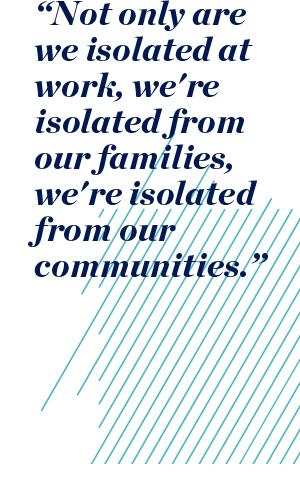 One of Arlund’s patients is a colleague of hers, a nurse who just a few weeks ago was working the wards alongside her. The union that represents the nurses is tracking 50 other members who have also been exposed.
One of Arlund’s patients is a colleague of hers, a nurse who just a few weeks ago was working the wards alongside her. The union that represents the nurses is tracking 50 other members who have also been exposed.
“She has been fighting for her life for several days now,” Arlund said. “There’s exposure everywhere, and our nurses are getting sick.”
“Being told that some of you are going to die, it’s grave. There are a lot of nurses who are trying to write their wills now,” she said. “We’re doing the very best we can to take care of each other because we don’t feel like our employer cares about us at all. Nurses are the worst at taking care of themselves.”
The physical distancing that so many Americans are practicing is much more personal for the health care workers on the front line of the battle against the coronavirus. Many are distancing from their own families, assuming exposure that puts their children and spouses more at risk. Some are staying in hotels or sleeping in spare bedrooms.
Arlund says she is lucky. Her husband is able to stay home with their children, and she has enough space to create an isolation zone in her house. At the end of her night shift, she takes a decontamination shower at the hospital, then drives home, where she strips in the garage. She makes a quick beeline to the shower for a second scrubbing. Her husband brings her dinner on a paper plate. There is no physical contact.
“I don’t hug my children,” she said. “Not only are we isolated at work, we’re isolated from our families, we’re isolated from our communities. It’s hard to say this without crying.”
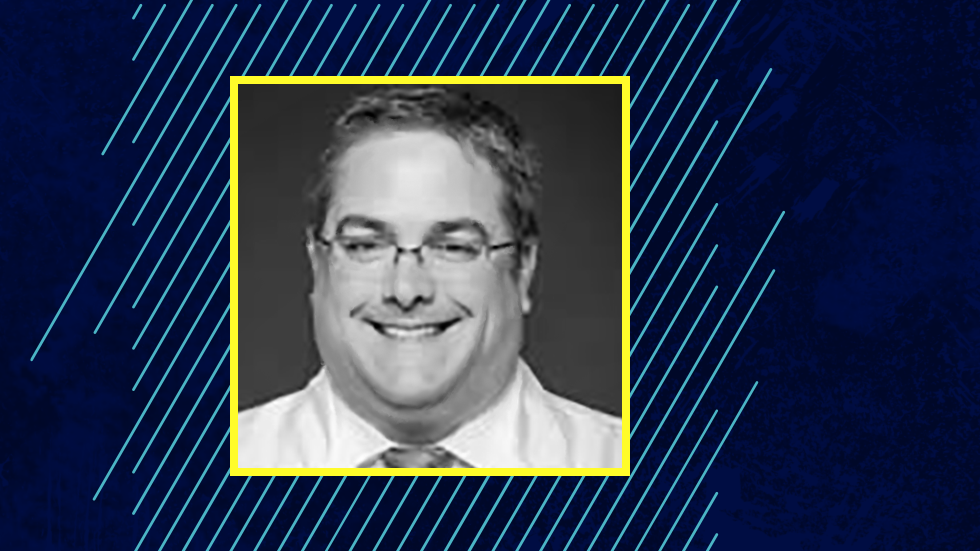
A disease that attacks the whole body
The people who ordinarily show up at University Hospital in Newark, N.J., are those with nowhere else to go. That’s why Anthony Rosania has been there for 15 years; it’s where he feels he’s needed most.
Rosania, the medical director of the hospital’s Emergency Department observation unit, has some experience with the threat of a deadly epidemic. When the Ebola virus broke out in three West African nations in 2014, University Hospital ran screening operations for passengers returning to the United States through Newark Liberty International Airport.
But within weeks, it became clear that their mission would no longer be about screening travelers; the virus had already landed.
“We had systems in place to identify and screen patients that may be arriving through Newark airport that would be possible patients with coronavirus. What really changed was starting in late February and early March, we started to have community spread in the U.S.,” Rosania said. “It sort of became obvious that we were going to see a large number of patients that was no longer just screening one or two people at the airport.”
Emergency room doctors are trained to respond to a variety of traumas: broken bones, gun shot wounds, car accidents, heart attacks. Those are no longer the patients who show up at Rosania’s doorstep.
How many of his patients have COVID-19?
“Speaking sort of generally, all of them. Pretty much every patient we see,” he said.
“The diversity of illness we see has just gone down,” he said. “We are probably seeing in terms of volume of patients the same number of patients we’ve seen before, except they’re all really sick.”
It has also become clear that the coronavirus that causes COVID-19 does different things to different people. Early on, doctors were told to watch for fever, shortness of breath and a deep cough. Now, patients are showing a broader variety of symptoms: mental confusion, blood clots, kidney problems, headaches, a loss of a sense of taste or smell. Rosania ordered a chest X-ray for a patient who could not stop vomiting; the X-ray showed advanced pneumonia, almost certainly caused by COVID-19, but the man had no trouble breathing.
“I could draw parallels, but there’s definitely no other disease state that we’ve seen before that manifests in such a diverse number of ways,” Rosania said. “It can impact any organ system, any part of the body.”
The stress of the outbreak has spurred some creative, and decidedly low-tech, solutions to help patients through the worst of the illness. More of Rosania’s patients are spending their days lying on their stomachs, rather than their backs, a practice called “proning” that may work because of the layout of a body’s internal organs. Most of the lung is toward the back of a body, behind the heart and stomach, he said. Someone lying on their stomach allows a bigger portion of the lung to do more work.
“You have all of this healthy lung tissue in the back that when you lie somebody on your back, gravity pulls blood to the back,” he said. “When you lie somebody on their stomach, you sort of recruit more of that healthy lung to do more of the work oxygenating the blood. What we’ve learned is you can do that for people who aren’t even on a ventilator.”
But not everyone can pull through, and Rosania said he had been shaken by the speed with which patients deteriorate. At times, someone whose oxygen levels are dangerously low can speak normally to a doctor — and then hours later find themselves needing assistance breathing or even a ventilator. Both doctor and patient know that life-and-death decisions are just hours away.
“That changes the process a little bit because you’re talking about what their goals of care are right there in real time as you’re preparing to intubate them,” he said.

The disaster expert
If anyone is prepared for the mental strain of a disaster, it’s James Phillips. The windows at his high school rattled 25 years ago this week when a massive bomb went off at the Alfred P. Murrah Federal Building in Oklahoma City; his father was one of the first firefighters to rush inside. Six years later, his firefighter uncle responded when planes hit the towers in New York. Phillips himself moved to Boston just months before the 2013 marathon bombing.
Some people might move to the least likely target they can think of. Not Phillips, who is now the chief of disaster and operational medicine at George Washington University School of Medicine and Health Sciences in the nation’s capital, just down Pennsylvania Avenue from another potential target.
“We are fortunate at GW to have a long history of disaster medicine and emergency management professionalism. When I came here I joined a team of emergency physicians who have been in the specialty of disaster medicine for decades,” he said. “That’s a factor of being six blocks away from the White House and being constantly in the crosshairs of every bad person in the world who wants to do bad things to America.”
In January, Phillips started paying attention to a new pathogen spreading in China. He took particular note that one of the first major announcements from China came from President Xi Jinping, who does not make a habit of commenting on small matters.
That indicated to Phillips that the virus “was probably larger in magnitude than we were being told.”
But when Phillips encountered his first coronavirus patient, he still found his options limited. The patient, a 50-year old fellow physician from another Washington-area hospital, complained of body aches and a low-grade fever. He did not have a cough, and he was breathing just fine. Under guidelines issued by the federal government, the man did not meet the criteria to be tested for the coronavirus.
Phillips tested him anyway.
“Because he was a health care provider, if he was to return to work with minimal symptoms he would be spreading that to patients. So I felt at the time that being a health care worker was a risk factor that wasn’t being recognized,” Phillips said.
Even now, he said, “if patients just show up, I still can’t get a test as rapidly as I would like. At some hospitals in the country, you can only get the rapid turnaround test, that 2-hour test, if people are sick enough that you know you are going to be admitting them.”
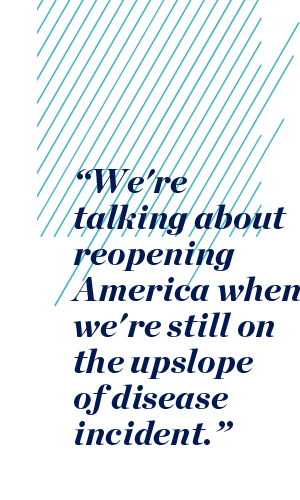 Many of the patients Phillips has seen shouldn’t even be able to form coherent sentences. The amount of oxygen in their blood is startlingly low, a fraction of what would be expected in a healthy individual and even sharply lower than people suffering from much more serious ailments. People whose lips should be blue are instead capable of speaking and breathing normally—- a condition physicians are starting to call “happy hypoxia.”
Many of the patients Phillips has seen shouldn’t even be able to form coherent sentences. The amount of oxygen in their blood is startlingly low, a fraction of what would be expected in a healthy individual and even sharply lower than people suffering from much more serious ailments. People whose lips should be blue are instead capable of speaking and breathing normally—- a condition physicians are starting to call “happy hypoxia.”
But their conditions can deteriorate rapidly. One woman who tested positive with only mild symptoms was sent home with a device to measure her oxygen levels. Ten days later, she returned to the emergency room breathing 60 times a minute, with just 68 percent of a typical oxygen level. Twelve hours later, she was on a ventilator.
Phillips is angry at what he hears from the White House, and from President Trump, who has claimed that anyone who wants a test can get one, and that protective supplies are plentiful. That isn’t necessarily the case at hospitals even blocks from the Rose Garden, where the president sometimes makes his pronouncements.
“Most emergency physicians in the United States are frustrated,” he said. “There’s a frustration amongst us because of a lack of [personal protective equipment], there are complaints that some hospital administrators are unsupportive and counterproductive, and quite frankly many of us are feeling a lack of support from our nation’s incident commander, which is the president.”
“To have your leader come out and say, ‘We’re doing fine, everything’s fine, nothing to see here,’ — it’s counterproductive to what we’re trying to tell our patients,” he added. “We’re talking about reopening America when we’re still on the upslope of disease incident.”
Phillips foresees a difficult moment he will face in just a few days. When he gets home, he calls his wife from the driveway. She scoops up their two-year-old son and they retreat to his room. Phillips strips naked in the garage, throws his clothes straight into the washing machine and takes a long, hot shower. His wife is less than a month away from her due date.
“We’re getting to a crunch time right now where I’m probably going to start living in the basement,” he said. “Because if I get sick sometime in the next week, not only am I going to miss the birth of my son, I also run the risk of having my wife get sick too.”
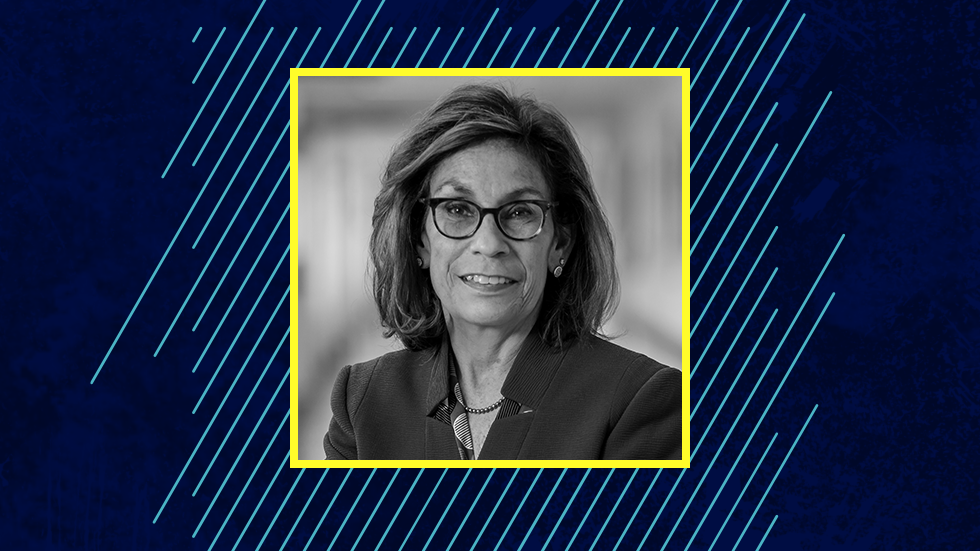
The captain of the ship keeping an eye on her crew
The six chief executives of hospitals in Bergen County, N.J., have two avenues of keeping in touch. Formally, their local hospital association convenes them for meetings. Informally, they spend their days in a group chat, texting each other when they need advice or supplies or to share observations about the COVID-19 patients flooding their emergency rooms.
They have prepared for this. They have run table-top exercises, assumed the worst, tested their generators and ventilators and rehearsed for mass-casualty events. Even the small details are checked off: They made sure they had updated telephone numbers for each staff member. They made sure their computer systems were updated to include the right code for ordering a coronavirus test.
When the first potential coronavirus case showed up at Bergen New Bridge Medical Center on Sunday, March 7, Deborah Visconi’s hospital got to experience a dry run. The patient tested negative.
“It was kind of nice that it happened on a weekend,” said Visconi, a 25-year veteran of hospital executive leadership who has run New Bridge for three years. “We are a community of providers. One of the things that’s come out of this is the fact that we’re all together, fighting the same enemy.”
Visconi’s hospital is in the midst of the largest outbreak in the United States, which has spread from the U.S. epicenter in New York to neighboring New Jersey and Connecticut. There are more confirmed cases in those three states, more than 355,000, than in any other nation in the world.
To prepare for a surge, New Bridge began reopening closed sections of the facility and reconfiguring units, adding a million square feet for new beds. A gymnasium once used for physical rehabilitation now has 40 new beds. Visconi herself hasn’t had a day off since the first week of March.
Visconi is confident that both her staff and the facility are ready. After all, coronavirus is not the first organism to threaten human health.
“At the end of the day, this is a virus. We can beat it, we’re smarter than it. As humanity, we’ve beat lots of stuff before this,” she said. “The academic part of me says we’ll be fine.”
But Visconi is already worrying about the next pandemic, one that will threaten the 2,200 employees under her command.
“We know that the next pandemic is going to be one of mental health,” she said.
New Bridge has already opened programs that will allow health care workers to see psychiatrists and counselors, in both individual and group settings. Visconi herself is talking more directly to her managers, the “hand-to-hand combat,” she calls it, of ensuring her staff gets the support they need.
“I’m human like everyone else. So while I’m in the middle of all this I’m stoic and strong like the captain of a ship,” she said. “It’s hard to not be able to hug your kid or your loved one. Those are tough moments, but at the end of the day we all want to live through this.”
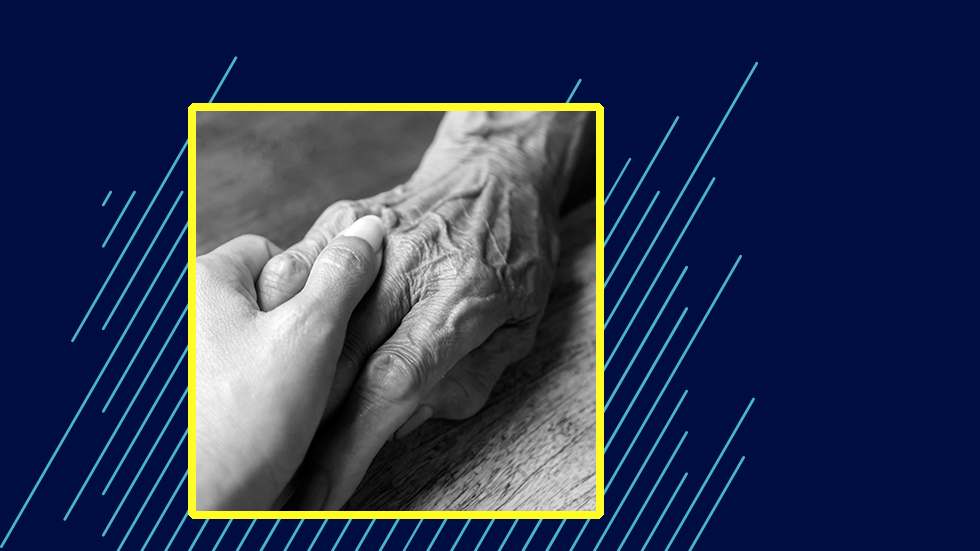
The nursing home
When he saw the first reports of a cluster of COVID-19 cases in a nursing home, Carl Shrader was nervous. Sundale Rehabilitation and Long-Term Care, the assisted living facility Shrader oversees in Morgantown, W.Va., is a long way from Kirkland, Wash., but the potential for the same type of disaster to strike his 98 residents was the same.
“It was amazing to me to see how bad things got so quickly,” he said. “I understand how it could easily happen, because there’s no pattern at all about how someone presents with this illness.”
By March 21, one of Shrader’s residents was ill with a fever and respiratory symptoms. They sent the patient to a nearby hospital in search of a coronavirus test. The hospital refused and sent the woman back to Sundale.
When her fever spiked to 103 later that night, Shrader called Morgantown’s other hospital, where the woman was tested. By mid-afternoon, Shrader got a page: The test had come back positive, the first confirmed incident of community spread in West Virginia.
“It certainly was a moment that changed my world. I was having a peaceful Sunday afternoon with my family,” he recalled later.
Shrader spent the rest of the day on the phone with West Virginia University’s command center, planning their response. A plan to test every resident and staffer in the building seemed prudent, and they had the swabs available — but they worried they would not have enough solution to keep the swabs protected on their way to the lab.
Nurses at Sundale found at least four more potential COVID-19 patients, and a fifth whose vital signs concerned them. The hospital only had four isolation rooms. But how would the emergency medical technicians in the ambulance transport the patients, and how would those patients be admitted to the hospital without putting others at risk? Those were questions Morgantown officials had not yet thought through.
In the meantime, Sundale locked down. Residents were isolated in their rooms. Family visits were forbidden. Nurses took vital signs every four hours. Meals were delivered on disposable plates and trays. The cleaning staff sanitized the entire building, focusing on “touch items” like bed rails, faucets and door knobs. Once the cleaning staff finished, they started all over again.
The following day, Shrader called in the National Guard. Soldiers screened half of the building’s residents, in the east side of Sundale where the first confirmed patients lived. A lab at West Virginia University and the state laboratory divided up the number of tests to process them more efficiently. The number of confirmed cases rose to 10.
Shrader’s phone rang at 4:30 the next morning. It was the adjutant general of West Virginia’s National Guard, offering his help again, if Shrader could round up enough swabs to test the other half of his residents. Hospitals in Morgantown contributed the swabs, and the university and state labs split them up once again. Five more residents tested positive.
Assisted living facilities almost never have isolation units, but Shrader’s team had to make one, quickly. They moved residents who had tested positive but showed only moderate symptoms into an area normally used for physical therapy. They decontaminated their rooms and moved others into them to create an isolation wing. The patients got their own space back, with a dedicated staff who cared only for them to further limit the spread.
Now, almost a month later, 21 of Sundale’s 98 residents have tested positive. Three have died, and a fourth was in critical condition over the weekend. Six residents have cleared the virus and returned to health. The improvised isolation wing worked.
“There are no signs of COVID spread in any area outside of our isolation unit,” Shrader said.
But even those residents who weren’t infected have suffered. Some were used to seeing their families regularly, even daily. Some don’t understand why their families have stopped coming.
“We shut this building down to visitors, and there are several residents who saw their residents every single day,” Shrader said. “We have seen an overwhelming amount of depression in some of those people, to the point where they didn’t want to eat or drink.”
Shrader understands the feeling. He has sent his three children, aged 6, 8 and 10 to live with their grandmother until he feels he would no longer be a threat to expose them. He saw his children on Easter Sunday, when his daughter handed him a letter.
“Dear Dad, I love you and I hope this corona stuff stops,” Elizabeth wrote. “I love you to the moon and back Daddy. I’m sad I had to live at Grandma’s for so long.”

Waiting for the rural surge
On an ordinary shift in a hospital in Western Michigan, Rob Davidson might be the only doctor working the emergency room. He likes working in a rural setting, a job he’s been doing for 18 years.
But more patients are showing up these days, and about half look like they have the coronavirus. The number of cases is on the rise, though the number of staff has not increased — there are no more doctors in rural Michigan to hire. The state government has expedited graduations for some nursing students just to meet the need.
 “I feel bad for our respiratory therapists, because when they’re not on, they’re on call,” Davidson said.
“I feel bad for our respiratory therapists, because when they’re not on, they’re on call,” Davidson said.
The coronavirus has hit hardest in America’s largest cities. It may be slower reaching rural America simply because lower population density means fewer chances for the virus to spread. The social distancing measures being taken across the country are working, Davidson said, though they are hard to abide by in an emergency room.
“So much of my job isn’t diagnosing bad things, it’s about reassuring parents about their kids and patients about their loved ones,” he said. Being required to stay 6 feet away “alters the way you care for patients. Most of my encounters with patients are standing at the doorway. That in and of itself is so contrary to the way I was trained and the way I practice.”
But rural health care workers know their surge is coming. The hospital system Davidson works for has already made preparations for a potential rush of COVID-19 patients. Its doctors, spread across several rural medical centers, now have the ability to surge into a particularly hard-hit hospital if needed. Those hospitals are prepared to triple capacity if necessary.
Still, supplies are already running low. Davidson is given one N95 mask, the type he needs to avoid catching the virus himself, that he must use for five straight shifts. There are only three ambulances that serve an area of 48,000 residents.
And Davidson, who heads the Committee to Protect Medicare in his spare time, is worried about what he’s hearing from colleagues around the country who are warning of tests that are coming back with false negatives.
“It’s concerning to me that there are all sorts of reports where we have negative tests who absolutely have the disease,” he said. “I haven’t heard enough people asking how good are these tests, and how do we make sure we have better tests?”
The negative tests and the physical distance are weighing on Davidson, but so is his family. He takes a sponge bath as he leaves the hospital after each shift, changes into clothes he keeps in a separate bag in his car. When he gets home, he uses gloves to put his clothes straight into the washing machine. He leaves his watch and his wedding ring, two surfaces on which the virus could potentially live, at home.
“The biggest mental strain, and I haven’t pulled the trigger yet myself, is when do I make the decision that I’ve been exposed at a high enough level that I’m going to isolate myself from my family,” he said. “If I had a kid with diabetes or a kid with cancer, I would probably be staying in a hotel right now.”
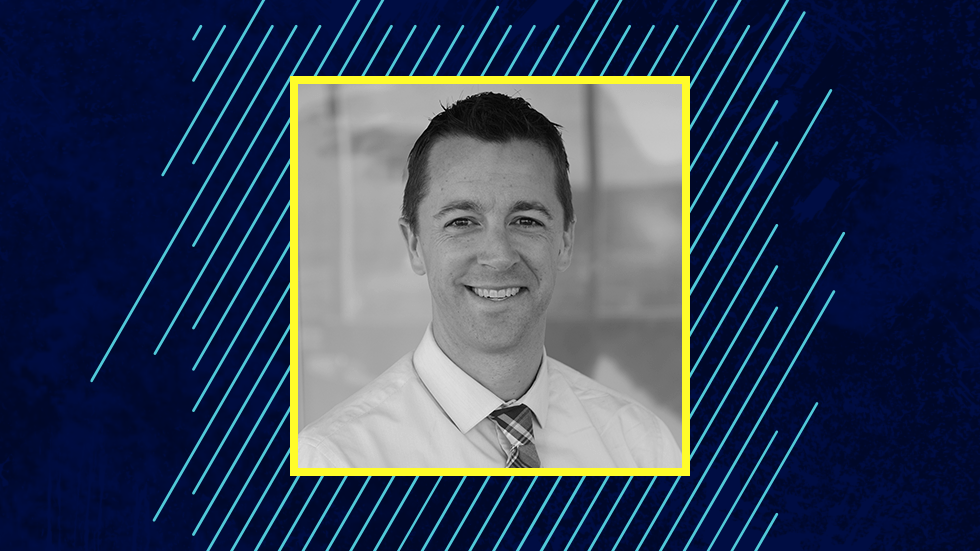
Caring for kids in the age of COVID
Even before the first confirmed cases of community spread of the coronavirus were confirmed in Washington state in late February, Kevin Carney suspected something might be going around.
Carney, who oversees pediatric emergency rooms and urgent care facilities at Children’s Hospital Colorado, said kids constantly have runny noses, many of which might be caused by other, less-devastating coronaviruses. But something this year seemed off, even at the peak of flu season.
“We’ve all been realizing that there’s been something out there that’s been a little bit different from the normal flu and the normal viruses that are out there this time of year,” Carney said.
As a pediatric specialist, Carney oversees a group of 180 doctors and hundreds more nurses who are in a unique and challenging position: Their patients, children, are far less likely to experience serious symptoms than are older people who come down with the coronavirus. But those kids are no less likely to contract — and, importantly, to spread — the virus.
“What we are challenged by significantly is the fact that kids do still carry this, and they carry it with either very mild symptoms like all the other colds or with no symptoms at all,” Carney said. “One of our biggest worries as a health care system right now is keeping our team members safe.”
Just days after Colorado reported its first case of COVID-19 in early March, one of Carney’s doctors called him shortly before he was scheduled to start a shift. The doctor had a fever and a cough; he later tested positive for the coronavirus, though he has recovered and is back at work.
Carney said he has been struck by the flow of information about the virus, and the evolution in the medical science behind it. His day typically begins at 5 a.m., when he checks academic models that forecast how the virus is spreading and reviewing the latest surveys and studies. An hour later, he is pounding out the first emails to his team, and by 7 a.m. the daily incident command briefing has begun. His fingers are now calloused from the number of directives he has had to type out and send to his team.
What worries him is the information he sees on the news.
“We are a group that, for good or bad, we are used to seeing terrible cases. We see bad traumas, we see child abuse, we see terrible stories that even in a normal world really challenge our resilience and our mental health,” he said. “Though we’re used to seeing clinical cases that challenge us and really stress us, we are not used to the added stress of thinking that our own health and safety is at risk.”
Zoom meetings, he said, have become a good way to blow off steam. Some doctors and nurses have started weekly Zoom-based happy hours. At least one virtual book club has taken off.
Business, though, is down. Fewer patients are coming to the emergency room, almost certainly because of the fear of being exposed to the virus. Telemedicine has been around for years, but its use has finally taken off as patients avoid medical settings. Carney can’t help but think how the coronavirus pandemic will change what is, after all, an industry.
“This is going to be with us for a while, and we have to get used to a different way of conducting ourselves both in the individuals in the health care system and, you hate calling health care a business, but it is,” he said. “It’s going to afford a rapid ascent of telehealth and other things that have been sort of waiting for a reason to gain momentum.”
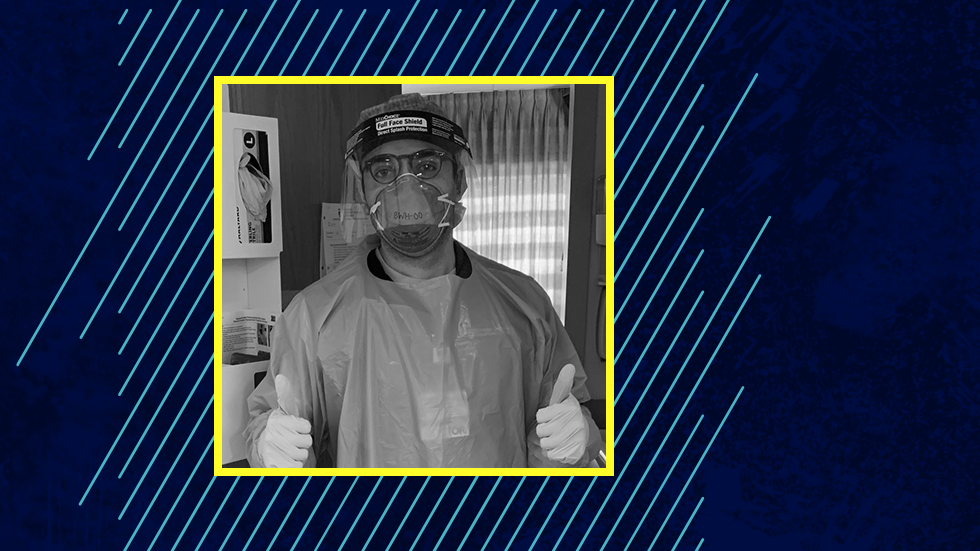
‘Like a runaway train’
Global health doctors and nurses know the value of supplies. Few nations around the world have health systems as strong as the United States. And when they deploy to developing countries, those doctors know they might have to improvise.
Abraar Karan experienced a lack of supplies when he worked in Rwanda in 2018. He did not expect to face the same sort of challenge in the emergency room at Brigham and Women’s Hospital in Boston.
“For us global health docs, we know what it feels like to be faced with a lot of uncertainty, to be faced with resource limitations,” Karan said. “Seeing that playing out here, where ventilators could become a limited resource at some point and having to talk to families about what’s the right thing to do, that’s on our minds a lot.”
 Boston has been one of the epicenters of the coronavirus outbreak in the United States. Brigham and Women’s had 159 COVID-19 patients in their beds as of Thursday, 73 of whom were in the ICU. The hospital set up a pod specifically for the patients; now that pod has overflowed.
Boston has been one of the epicenters of the coronavirus outbreak in the United States. Brigham and Women’s had 159 COVID-19 patients in their beds as of Thursday, 73 of whom were in the ICU. The hospital set up a pod specifically for the patients; now that pod has overflowed.
The internal medicine department is “pretty much all COVID at this point,” Karan said, adding that he had been struck by the speed at which the virus can go from bad to worse.
“We’ve had patients who were totally on room air, admitted breathing comfortably. A few hours later, those patients are having trouble breathing, on oxygen, and the next day they could be in the ICU,” he said. “We have to really anticipate who’s going to do poorly and make sure to have them closely monitored. But a lot of times it’s like a runaway train. There’s not much you can do.”
The typical patient traffic is down, Karan said, and he wonders where the heart attacks and strokes and broken arms have gone. But in a way, so many people avoiding the hospital has made the task of diagnosing a patient significantly easier.
“Normally when I get a patient with a fever, it’s going to be one of 20 things. And now the first thing and second thing and third thing on our minds is COVID,” he said.
At the end of his shift, he has taken new pleasures in the smallest things. The N95 masks he must now wear at all times are stifling; they work well, but they make breathing more difficult. Now Karan relishes taking off the mask.
“The ability to breathe is so refreshing,” he said.

An evolving understanding, and heightened fears
Matthew Scro has been working in emergency rooms for more than five years. But now, when he walks into the emergency room at New Bridge Medical Center in Paramus, N.J., he gets an eerie feeling.
“Just walking through the ambulance bay into the [emergency department] is an ominous site. Everyone is wearing masks and gowns, you see multiple patients on ventilators,” said Scro, an attending physician in the emergency department.
At the heart of an outbreak that began in New York and has spread to suburbs in New Jersey and Connecticut, hospitals like New Bridge are beginning to see their case counts rise. Scro estimated that about two-thirds of patients in his hospital have the coronavirus, and a quarter of those need to be treated in the ICU.
“The sheer numbers of patients are exponentially going up over the last few weeks. The fear in both the community and the staff has gone up as well, and rightfully so,” he said.
That alarm is rising, Scro said, as they learn more about the virus itself. In the early days, when testing was limited to those who were at high risk of contracting the virus either through exposure to those who have already had the virus or through travel to impacted areas, doctors looked for a combination of three particular symptoms.
Now, new information from hard-hit areas in China, South Korea, Italy and elsewhere, as well as America’s own experience with the virus, has dramatically broadened that set of potential symptoms.
“The way that we are approaching it is definitely rapidly changing. Initially we were suspecting patients coming in with the triad of fever, shortness of breath and cough. Now, any constellation of symptoms could be COVID,” he said. “Our threshold for suspecting COVID patients has gone down significantly.”
These days, when Scro goes back across the river to the Manhattan apartment he shares with his wife, he tries to practice the self-quarantining he wants others to emulate.
“We’re trying to limit our exposure to other people, knowing that I myself am at higher risk,” he said. “It’s definitely an unsettling time. I’m going to work now both aware of my own personal safety as well as my patients’s safety.”
Copyright 2023 Nexstar Media Inc. All rights reserved. This material may not be published, broadcast, rewritten, or redistributed.

